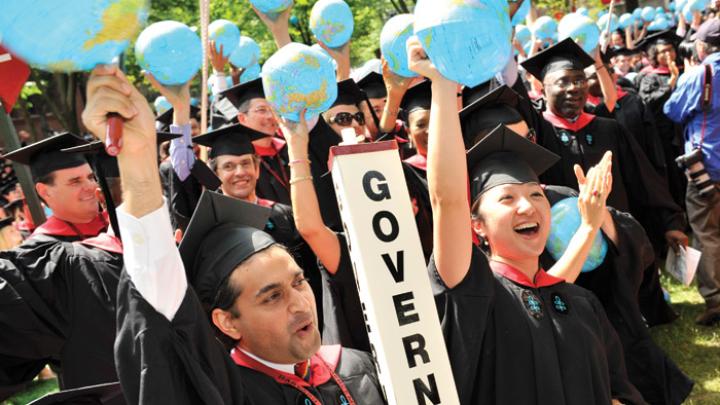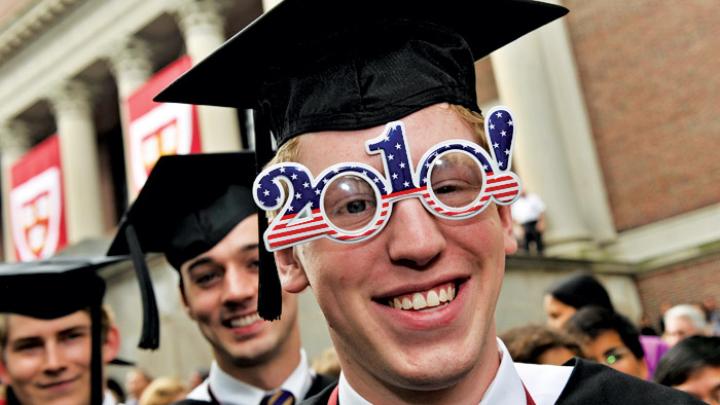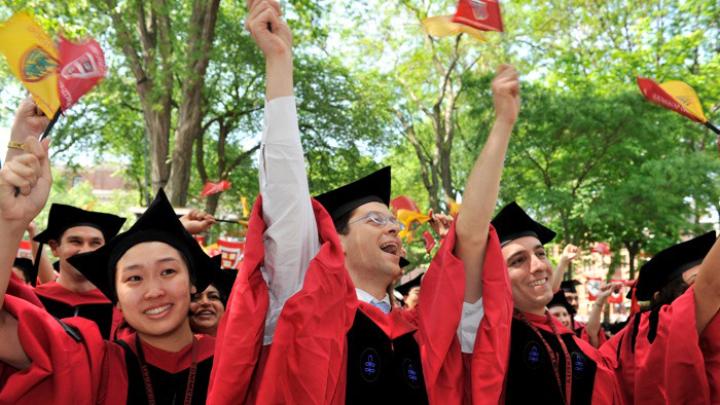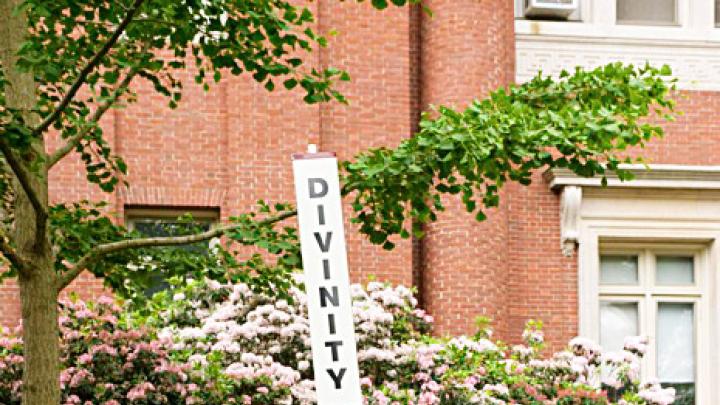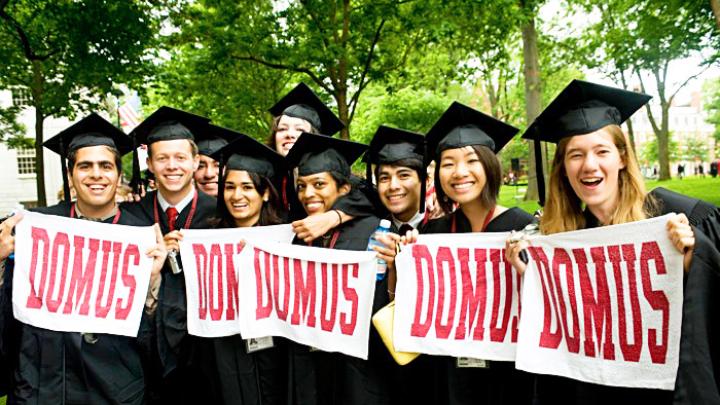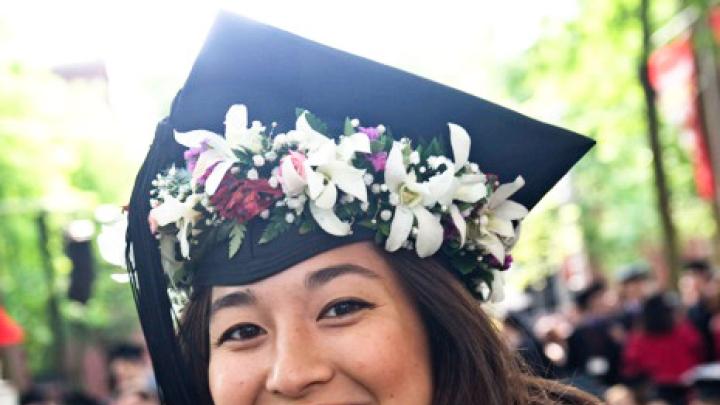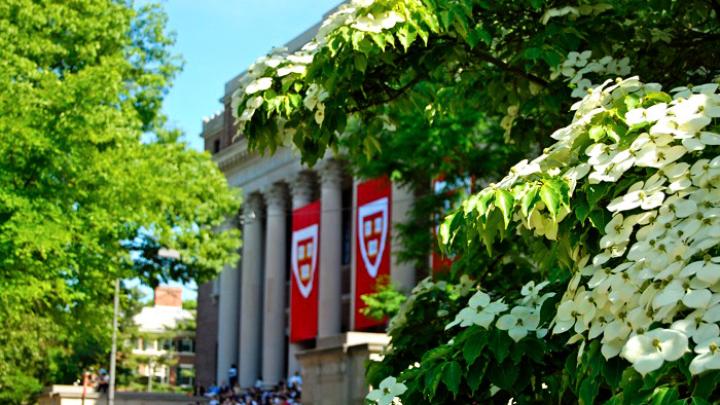The weather gods obviously got the memo late. As the University concluded its first year on a new academic calendar, the 359th Commencement arrived a week earlier, in May. You know, spring. The rhododendrons at Massachusetts Hall and Loeb House, bracketing Harvard Yard, still in bloom. The kousa dogwoods’ white bracts framing the walkway between University Hall’s granite and Weld Hall’s brick. Locust and yellowwood blossoms wafting down on the Tercentenary Theatre throngs.
But no sooner had the seniors put on their gowns for the Tuesday Baccalaureate exercises in Memorial Church than the thermometer jumped to a near-record 90 degrees. Concluding the prayers of the day, Bernard Steinberg, president of Harvard Hillel, prefaced himself to address the Reverend Peter J. Gomes: “I implore you to put some air-conditioning into this holy space. And to President Faust, I implore you to fund it.” (One of them was amused. For an excerpt from Faust’s address, see “Tend to Public Good,” page 52.)
Wednesday was 92 degrees, one shy of the Depression-era record. During Class Day, lines formed at water stations in the Yard. People played musical chairs, moving as the sun shifted while the ceremony wore on. Perhaps they had other motives, but a senior’s mother and sister, down from Toronto, said they had to make an emergency run to Filene’s Basement for cooler clothes.
Then, somehow, the meteorological message got through. Shortly after the honorands and guests dispersed from the Wednesday evening banquet in Annenberg Hall, a thunderstorm ripped through. It was sufficient to deliver a 70-degree, sun-and-clouds Thursday morning: perfect backlighting for crimson banners and celebrants’ funny hats and props. Whatever kinks may have attended the new academic schedule, the Happy Observance of Commencement Committee had ironed them out. Spring indeed.
The serious theme of the week was public service. President Faust wove that thread throughout her Baccalaureate, and made it the subject of her Commencement Day text. She ended the former by quoting a 1966 address Robert F. Kennedy ’48 gave in Cape Town (“…we live in interesting times. They are times of danger and uncertainty; but they are also more open to the creative energy of men than any other time in history”)--thereby tying together a year that had included her own visit to Soweto last November.
The Class Day speaker, CNN journalist Christiane Amanpour, also quoted RFK (as did Harvard College dean Evelynn Hammonds). Speaking from experience, she told the soon-to-be-graduates about being a young woman in Iran when “revolution rumbled across my country.” It “forced me to suddenly become an adult in a turbulent world, after a calm and privileged childhood,” she said. No matter what career they choose, Amanpour urged the seniors to travel, to learn from other cultures, and to share their own values with others.
She noted how then-Secretary of State George Marshall, announcing the Marshall Plan during his 1947 Commencement speech at Harvard (see "The Ultimate Commencement Address," May-June 1997), declared, “[T]he people of this country are distant from the troubled areas of the earth and it is hard for them to comprehend….” That, she said, “is precisely the same today.” She challenged the class of 2010 to live life “fully informed, fully aware, and fully on board.”
The students apparently lean that way. The Crimson’s senior survey revealed that 17 percent of respondents chose public service as their “dream” job; another 14 percent chose the arts. But, facing facts, only about 15 percent of the class indicated they will be working in those fields.
A few hours earlier, during the Reserve Officers’ Training Corps commissioning ceremony, Paul G. Kirk Jr. ’60, LL.B. ’64 (once an Army ROTC cadet himself), told the dozen cadets and midshipmen that in accepting the challenges imposed by their demanding extracurricular choice, they had already demonstrated leadership. They were first in their class to answer “a fundamental question: not ‘What shall I do with my Harvard degree?’ but ‘Once I’ve received a Harvard education, what shall I do as a citizen?’” (Kirk recently completed his latest tour of duty as a public servant: filling the U.S. Senate seat of the late Edward M. Kennedy ’54, LL.D. ’08, on an interim basis.)
At the honorands’ dinner, Faust noted of Freeman A. Hrabowski III--a national leader in promoting minority students’ success in math and science--that he took part at age 12 in the children’s march for civil rights in Birmingham, Alabama, in 1963, and was arrested. And introducing the week’s most prominent public-service guest, Faust cited the Honorable David H. Souter ’61, LL.B. ’66, “for advancing, with independence and empathy,” what Daniel Webster called “the great interest of man on earth”--justice. (Her source, replete with Supreme Court and Harvard ties, was the funeral oration for Justice Joseph Story, A.B. 1798--also an Overseer, a Corporation member, and a Law School professor.)
Commencements principally celebrate the young. But experience and wisdom (okay, age) are also served at the Harvard festivities, which include the principal reunions and, of course, the honorands themselves (note all the 1950s and ’60s Harvard advanced degrees; see below).
The classes that graduated in 1960 abound with people whose lives shaped generations: Robert E. Rubin ’60, LL.D. ’01, former U.S. Treasury Secretary and Goldman Sachs and Citigroup executive, a member of the Harvard Corporation; the Honorable Antonin G. Scalia, LL.B. ’60, of the Supreme Court; former U.S. Senator Elizabeth Dole, M.A.T. ’60, J.D. ’65; and so on. In academia, consider the vigorous longevity of Charles Maier ’60, Ph.D. ’67, and Pauline Rubbelke Maier ’60, Ph.D. ’68, professors of European and American history, at Harvard and MIT, respectively. Or the Energizer Bunny of University administrators, John P. Reardon Jr. ’60 (universally, “Jack”), the deeply engaged executive director of the Harvard Alumni Association.
But the passage of time was palpable. After those quotes from Robert Kennedy, Faust’s Commencement afternoon reference to President John F. Kennedy ’40, LL.D. ’56, only heightened the effect--as did the presence of his daughter, Caroline Kennedy ’80, and her husband, Edwin Schlossberg, attending the graduation of daughter Rose ’10.
Even the class of 1985’s secretary and twenty-fifth anniversary report chair, Mary K. Warren, couldn’t help observing time fly. “Remember when there were such things as carbon paper, rotary phones, typewriters, busy signals, three networks, telegrams…?” she wrote. “In the 1980s, it was ‘Morning in America’…and People Express charged $29 to fly us from Boston to New York.”
One change that was under way in 1985--less so in 1960--was much in evidence during the week: the advance of feminism.
Phi Beta Kappa Orator Natalie Zemon Davis, A.M. ’50, LL.D. ’96, a leader in the creation of women’s history, deftly probed that learned society’s fumbling engagement with women in the late nineteenth and early twentieth centuries, when there was much debate over “widening the circle of scholarly excellence” to include both genders. She then recounted the birth of the history of women in the late 1960s and early 1970s--in her immediate experience, through friendship and joint study with Jill Ker Conway, Ph.D. ’69 (who later became Smith College’s first woman president).
At the Radcliffe Institute for Advanced Study, a Friday morning panel on “Feminism: Then and Now” found journalist and author Susan Faludi ’81, RF ’09, lamenting that the attitude of young women today might be aptly described as “feminism now and then.” She said, “Feminism’s progress is too often a spasmodic stop-and-start affair, with great bursts of mobilization followed by long periods of quiescence and partial amnesia.” Though she doesn’t oppose cheering the gains women have made, Faludi said, “all of this celebration should not obscure how far women still have to go.”
In a peppery speech that afternoon, Radcliffe Medalist Gloria Steinem, cofounder of Ms. magazine and the National Women’s Political Caucus, declared herself a “hope-aholic.” Offering a “Top 10” list that meshed nicely with the commemoration of the institute’s first decade, she observed, “Don’t ever believe that men can’t change” (Number 10). She cited the notion that once prevailed: only women possessed the fine-motor skills to type. “Suddenly computers appeared and voilà! Men could type!” Number 6 was: “Nothing much is going to change until men are raising children as much as women are,” with its corollary, “Women won’t be equal outside the home until men are equal inside the home.”
Steinem concluded by challenging Radcliffe’s fellows to be “the source of transformative thought” on initiatives that could shake up the world, in realms from economics and law to religion and politics. She declared that Radcliffe might one day even render “all the other so-called ‘tubs’ of Harvard--the Business School, the Law School, the Divinity School--a little boring. Why? Because you’ll be dealing with causes, and all the rest will be dealing with effects.”
It was the courtly Justice Souter, speaking the prior afternoon, who captured the changes entrained from his College years to the class of 2010, and the good that had resulted. Beginning his address after introductions by Alumni Association president Teresita Alvarez-Bjelland ’76, M.B.A. ’79, and Harvard president Faust, he said, “Thank you more than I can say. Madam President…Madam President--it’s becoming habitual.”
